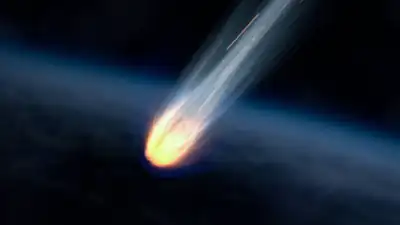ARTICLE AD BOX

You know that moment when you’re half asleep, maybe scrolling through your phone, and then BAM — the sky lights up like someone lit a fuse across the dark canvas above? That was in Delhi-NCR not long ago.
A bright streak, a trail of fire, fragments breaking apart mid-air, possibly even a rumble or two heard by some. Everyone paused. Phones came out. Social media exploded. Was it a meteor? Space junk? A bolide? Around 1:20 AM on September 20, 2025, people across Delhi, Noida, Ghaziabad, Gurgaon, saw something unbelievable: a bright fireball streaking across the sky, breaking apart into glowing fragments. Some said it looked like a “shooting star explosion.”
Some claimed they heard a rumble afterward. Almost instantly, phones were up, and videos were everywhere.There’s a twist: some scientists think this might not have been purely natural meteoroid debris, but rather space debris, possibly from China’s Long March 3B rocket stage re-entry. This event over Delhi was visible over a huge area. The brightness was enough to outshine city lights, at least briefly. It was rare and spectacular.
People compared it to cinematic scenes. It was the sort of thing that makes you stop, shut off the phone, stare upward for a second.
First, some quick definitions, so we’re all on the same page.A meteoroid is just a chunk of rock or metal floating in space.When that chunk enters Earth’s atmosphere and starts burning up, we call what we see a meteor — a shooting star, basically.If part of it survives the fiery entry and lands on Earth, that piece is called a meteorite.Now, not all meteors are created equal. Some are barely visible streaks, others flame so bright they light up entire city skies, and a few even make a boom. What causes those differences? It’s a mix of size, speed, composition, angle, and altitude where things happen — and sometimes there’s man-made stuff in the mix (yes, space junk).
Size & mass
Smaller meteoroids — pebble-sized or less — usually burn up quietly. They’re like popcorn kernels in the atmosphere: heat builds, they glow, then they vanish without much drama.
Bigger ones, though — think rocks tens of centimeters across (or more) — have more material, more inertia, so when they hit the very high-speed friction with air, the heating is intense. That can lead to explosive disintegration.
Speed
Meteoroids travel fast (tens of km/s). The faster they’re going, the greater the friction and pressure on their front edge as they hit the thickening layers of atmosphere. That means faster = more heat = more chance of bursting.
Composition
It matters what the rock (or metal) is made of. Some are very dense (iron, nickel), others are more fragile (stony, porous). Fragile meteors often cannot survive that build-up of pressure — they crack, break, burn up in pieces. Dense ones might hold together longer, maybe even survive low enough to hit ground (meteorite).
Angle of entry & altitude
A meteoroid plunging more steeply will face intense heating quickly and may explode high up. One entering at a shallow angle might skim more of the atmosphere, maybe burn longer, fragment differently, sometimes skip out, sometimes disintegrate quietly.
Altitude (how high it starts burning up) changes how long you see it, how loud any boom is, whether fragments might reach ground.
Fragmentation
This is often the dramatic showstopper. As heating and pressure rise, cracks form, pieces break off, lighting up and spreading debris — that’s what gives us glowing fragments, smoke trails, sometimes the “shooting star explosion” type effect. And if enough of it breaks quickly, there can be audible shock waves or booms (though that depends on how big the fragments are, how close the break is, and how loud things are in the area).As of now, there is no official statement on the meteor shower that happened in the Delhi NCR on Saturday.



.png)
.png)
.png)
















 2 hours ago
4
2 hours ago
4









 English (US) ·
English (US) ·